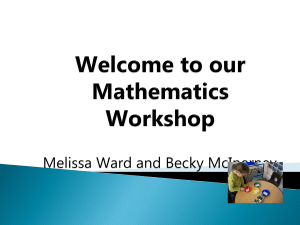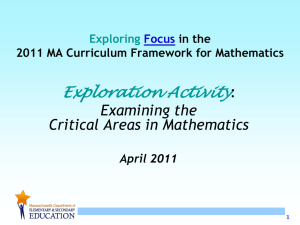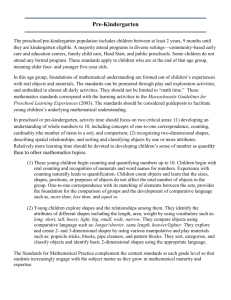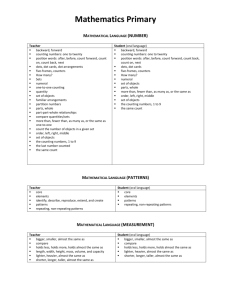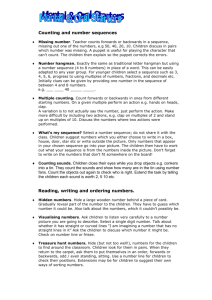maths leaflet
advertisement
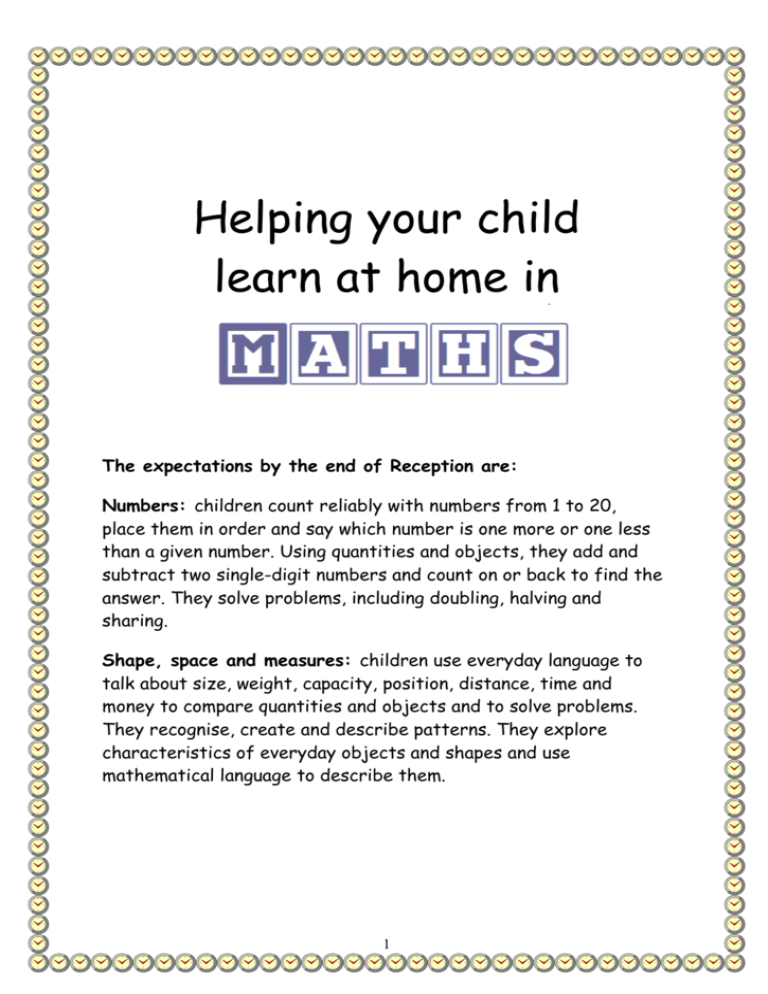
Helping your child learn at home in The expectations by the end of Reception are: Numbers: children count reliably with numbers from 1 to 20, place them in order and say which number is one more or one less than a given number. Using quantities and objects, they add and subtract two single-digit numbers and count on or back to find the answer. They solve problems, including doubling, halving and sharing. Shape, space and measures: children use everyday language to talk about size, weight, capacity, position, distance, time and money to compare quantities and objects and to solve problems. They recognise, create and describe patterns. They explore characteristics of everyday objects and shapes and use mathematical language to describe them. 1 In the street Recognising bus numbers. Number plate hunt. Who can find a 10, 13? Comparing door numbers. Counting – how many lampposts on the way to school? How many steps from one point to another? Do mum or dad need to take the same number of steps? Do they take more or less? Directions - behind the post box, in front of the house, next to school. Use ordinal numbers (1st, 2nd, 3rd) as well as cardinal (1,2,3) e.g. What colour is the third car you see? Doing the washing Counting in 2s – matching shoes/ socks. Sorting by colour and size. Find four shoes that are different sizes. Can you put them in order? What patterns can you see? 6 black socks and 4 white socks. How many in total? 2 Time What day is it yesterday, today, tomorrow? When are family birthdays? Use timers, phones and clocks to measure short periods of time. Count down 10/ 20 seconds to get to the table/ into bed etc. Recognising numbers on the clock. If you cover a number, what number was missing? Food! Can you cut your toast in half? Can you cut it into triangles/ other shapes? Setting the table. Counting the right number of plates etc. How many more do we need? If someone is not home - do we need the same number? Do we need more or less? How many fewer? Can you make patterns out of the knives and forks. Can you put them in the right place in the drawers? Helping with the cooking by measuring and counting ingredients. Use the language of weighing and capacity e.g. heavier, lighter, full, empty. Setting the timer. 3 Positional language at dinner time: what is on the rice, where are the carrots etc? Going shopping Reading price tags. Counting items into the basket. Finding and counting coins. Getting change. Comparing weights and sizes. Writing and using numbers Make own number tracks and lines - match to numbers of objects. Make large number cards (as decorative as you like) and use to order random numbers e.g. 13, 17, 18, 20. Measuring Are you taller than a …? Marking height on the wall. Cut hand or feet shapes out of paper. How many hands long is the sofa? How long is the table? Which is longer? Who has the biggest hands in our family? 4 Shapes Cut a potato into shapes (circles, triangle etc). Use with paint to make pictures and patterns. Cut out shapes from coloured paper/ newspaper and arrange into pictures. Shape hunt: Can you find a square in your house (windows etc), a circle … 3d shapes: a tin is a cylinder, dice are cubes, an ice-cream cone is a cone! What shape is a lego brick? How many faces on a die? What 2d shape are they? Use mathematical language when talking about shapes. Flat shapes (circles, triangles, squares, rectangles and hexagons) have sides and corners. Solid and hollow 3d shapes (cubes, cuboids, pyramids, cylinders and spheres) have edges, corners and faces. Playdough Here’s a simple recipe: 1 cup of plain flour 1 cup of water 5 1 tablespoon cooking oil 4 teaspoons cream of tartar Half a cup of salt food colouring and essences (optional) Put all ingredients in a large saucepan, and heat slowly, stirring all the time until it forms a ball. Keep it wrapped in clingfilm or in a covered tub to stop it drying out. Then …. Make numerals and 3d shapes. Sort shapes into groups, or order by size. Make long and short snakes. Can you make a straight snake? Can you make a curved snake? Games Ordering numbers with playing cards - clock patience. Jigsaws. Dominoes or snap - talk about the double numbers made when the cards match. ‘10 and’ - instead of looking for doubles, play as ‘snap’, looking for a picture card or 10. When one is turned over, the players call out “10 and..” Help your child work out what teen number they have made e.g. a king and a 4 = 14, a queen and a 7=17, 6 etc. Vary by calling “10 take away” and helping your child work out the subtraction sum. (Fingers help!) Snakes and ladders or other simple dice games counting on from the space landed upon. Adding numbers on two dice or on a domino. Find all the dominoes with numbers that add to 6, 10 etc. Bingo, with numbers or shapes. Target games - keeping score. 7 Internet maths games: http://www.topmarks.co.uk/ordering-andsequencing/caterpillar-ordering http://www.familylearning.org.uk/online_math_games.h tml http://www.iboard.co.uk/teacher/Poppytop/3 (select Home/School links folder) http://www.ictgames.com/resources.html Apps Kids learning - my first numbers counting game grasshopper app - free (numbers up to 20) Maths age 4-6 - one billion app - free - this one is very good. Aliens and numbers - games for kids to learn maths and practise counting - free Elmo loves 123s Big Numbers - free - numeral recognition Big Number Trace - free - number formation to 25 The math tree - £0.69 - addition and subtraction ICT games Beebot - free Daisy the dinosaur - coding - free Number jacks - £1.49 8


